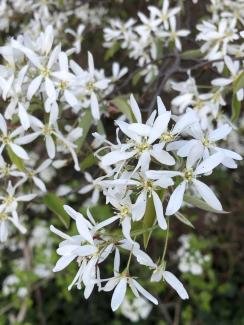
Habitat: woods, along river banks, swamps, and rocky slopes; more common at lower elevations. In a wide range of mesic to dry upland forests, woodlands, and barrens; occasionally in alluvial forests, seepage wetlands, and depression swamps; tolerant of a wide range of soil chemistries. The ecological amplitude of this species is likely due to the incorporation of several ploidy levels and microspecies. Common throughout.
Wildlife value: used by 58 wildlife species; 35 bird species; important early summer food
Notes: Serviceberry is a multitrunked shrub or small tree with a rounded crown and grows 15 feet tall. In the wild, it can grow significantly larger than in the landscape. It forms root suckers, and if they are allowed to grow, it will result in the plant growing as a shrub rather than a tree. Over time, the suckers will cause the plant to form a small colony. Pruning should be done in the fall in order to avoid excessive loss of sap.
Edibility: Edible fruit used to make jams, jellies, and pies. Can be eaten raw or cooked. Rich in iron and copper.
Carniola Farms Nursery
Nursery operates Arlington Native Plants & Edibles located at 925 N. Madison St. Arlington Virginia 22205. Plants can be purchased at any time by making an email appointment at carniolafarms@gmail.com. Also, during the during the planting season, they are open some Saturdays from 11AM to 3PM. Check their website for datesThis plant list is from the beginning of the 2025 season and may be out-of-date
| In Stock? | Notes | ||
|---|---|---|---|
| Yes | View My Wishlist |


